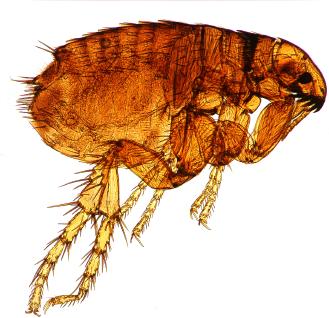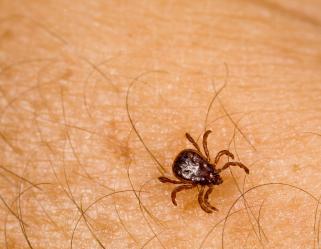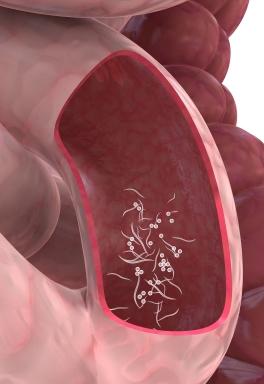|
Your Dog, Fleas, Ticks, and Worms, Oh My!!
It's summer, the weather's been great, and you and your dog have been enjoying lots of together time outdoors. You're both having a blast, but lately your CBF has been awfully itchy and twitchy. Every time you look at him, he's fidgeting with his flanks, biting his belly, or gnawing on his paws. It's driving you both crazy!! Could he have fleas? Or some other nasty critter? Does this mean you're not the great 'pup parent' you thought you were? 
Fleas First of all, if you suspect that your pup has fleas, don't blame yourself. A pet that spends any amount of time outdoors during warmer months is almost guaranteed to get fleas or other parasites. Fleas are the most common. They absolutely LOVE to take up residence on your pup's body and feed off his blood (yuck) and have LOTS of flea-babies. To see if your CBF has fleas, roll him over on his back and look at his belly where the fur is sparse. If you see little black specks, you're looking at 'flea dirt' (actually flea poop--another yuck). Sometimes you'll be able to spot one of these evil critters running across your pet's belly. They're a dark reddish-brown color and about a third the size of a grain of rice--unless they've just had a meal courtesy of Fido, in which case they'll be a little more plump (triple yuck). If you're lucky, you may be able to grab and remove the flea before it scurries out of sight. I've found the best place for these guys is a swim in the 'circular spa' (toilet). But don't be discouraged if you can't catch the fleas--they move VERY quickly and can leap heights many times their size. (Picture yourself jumping the height of the Empire State Building, and you'll understand.) Since fleas also bite humans, and can hang out in your furniture and carpeting, you need to get rid of them as soon as possible. 
Ticks Ticks are not actually insects; they have eight legs like spiders, and belong to the arachnid family like spiders (yuck again). Ticks like to hang out in tall grasses and weeds and will attach themselves to a host (your dog--or yourself), from which they will burrow into the host's skin and feed off the blood. Ticks carry several serious illnesses, such as Lyme disease and Rocky Mountain Spotted Fever. Lyme disease is the most common tick-borne disease in the United States and is characterized early on by fever, fatigue, and a skin rash, followed by swollen joints. This disease can also affect your dog's heart and nervous system. The usual treatment is antibiotics, but the disease can linger and become harder to treat. Rocky Mountain Spotted Fever is characterized by sudden onset of fever and muscle pain, followed by a rash. This disease is treated with antibiotics, but is hard to diagnose in its early stages and can prove fatal. If you've been wandering through fields of long grass or weeds with your dog, you'll need to check him for ticks. If you find any, first put on a pair of rubber or surgical gloves before attempting to remove the offending arachnid. You don't want your own skin exposed to any diseases the tick may carry. Then soak the tick with rubbing alcohol. This will temporarily stun the tick, so it will loosen its grip on his skin. Then, using tweezers, grasp the tick's body as close to the head as you can, and pull gently until you feel the tick let go. Make sure you get the whole tick and not just the body--if the head is left, there is a higher chance of infection, and requires a trip to your veterinarian. Next, drop the tick in a jar of rubbing alcohol to finish him off completely. Disinfect the area where the tick was, using iodine or another antiseptic wash. Rubbing alcohol works, but is too irritating on an open wound, so try to use something else. Lastly, wash your hands to get rid of any germs the tick may have left on your skin. Here are some weapons you can use in your war against fleas and ticks: 1. Advantage--a once-a-month liquid that goes on the dog's skin between the shoulder blades. It contains imidacloprid, which stops fleas from biting within 3 to 5 minutes of application, begins killing fleas within an hour, and kills 98-100% of fleas within 12 hours of application. Click on the link to learn more about Advantage. Advantage 12pk Dog Red 21-55 Lbs 2. K9 Advantix--similar to Advantage, with the same once-a-month application, but also contains permethrin, which kills ticks and mosquitoes. Click on the link to learn more about K9 Advantix. K9 Advantix 12 Pk Teal Dog 11-20 Lbs
Because both of these formulas act so rapidly, they are helpful for pets with Flea Allergy Dermatitis, which can be triggered by the bite of just one flea. I had a dog several years ago with this condition, and one flea bite would send him into a total itching frenzy. He ended up with hot spots and missing fur from all the scratching--and he didn't even have that many fleas. 3. Frontline and Frontline Plus--also used once a month. Both of these contain fipronil, which affects the parasite's nervous system, causing paralysis and death. These formulas will kill 100% of fleas and ticks within 24-48 hours; fleas are generally killed before they have a chance to bite. Frontline Plus also contains a substance which prevents fleas from maturing or reproducing. Click on the following link to learn more about Frontline. Frontline 12pk Medium 23-44 Lbs 4. BioSpot On--another once-a-month formula. Kills and repels adult fleas and ticks and stops the development of immature fleas. Click on the following link to learn about BioSpot On. Bio Spot For Dogs Over 66 Lbs Flea & Tick 3 Pk If you think flea and tick treatments are expensive, there's one thing you really need to know--if you think that fleas aren't a big deal, and you don't really need to do anything about them because 'every dog gets them', bite on this: The Black Plague that struck Europe several times during the Middle Ages and wiped out roughly one-third of the population was brought into the area by the fleas that were feeding off rats that lived on trading ships. Fleas spread disease. They infest your other pets and your household. The sooner you can get rid of them, the better off you, your dog, and your entire household will be.

Worms--Yuck!! Worms are a very common canine problem. And because they are so common, there are lots of ways to treat and eliminate them. The most common types of worms are roundworms, hookworms, tapeworms and whipworms. Many puppies are born with worms simply from contact with the mother dog, so it's important that pups get treated at a very young age to eliminate these internal parasites. Roundworms live in your dog's intestines after he has eaten something contaminated with the larvae. They can grow up to seven inches in length and can be seen in feces. They look like wiggly spaghetti. Hookworms latch onto your pup's intestinal wall after he has ingested the larvae--or they have penetrated his skin. They drink a lot of blood and are about 3/4 inch long, with a bend in one end like a hook. Whipworms live in the colon after the eggs are ingested. Since they don't show up in feces until about three months later, it's tough to diagnose these. They are about three inches long, with a one end thicker than the other, like a whip handle. Tapeworms are transmitted by infected fleas, which your dog swallows while chewing at a flea bite. This worm can grow up to thirty-two inches in length (yuck again!) and is long, flat, and segmented. Each segment contains eggs, and the segments can be passed individually in feces. They resemble grains of rice.
Puppies are usually treated for worms at about two to three weeks of age, not only to eliminate them from the dog, but also to prevent the spread of the infestation through waste. If you're using a flea control, you're also controlling tapeworm--eliminating two types of parasites at once. You also need to clean up after your pet as often as possible to prevent re-infestation. De-worming medications can be purchased from some pet-supply companies without a prescription. But PLEASE check with your veterinarian first before ordering or administering any medications. Heartworm Heartworm is an extremely serious parasite that is spread by infected mosquitoes. It is potentially fatal but fortunately also highly preventable through the administration of a monthly oral preventive. Heartworm appears as long, spaghetti-like strands, and a heart with an advanced case appears to be totally enveloped in these strands. There is about a six-month incubation period from the time the infected mosquito bites the dog and deposits the immature larvae to the time the mature male and female worms have mated and migrated to the heart, where the female begins reproducing. During this six-month period, your dog may not show any symptoms at all. Typical symptoms include coughing and excessive fatigue with exercise. As the disease progresses, additional symptoms are fainting, coughing up blood, weight loss, and lastly, congestive heart failure. Heartworm infections are diagnosed by a blood test and also an x-ray to determine the amount of lung damage. Heartworm prevention is easily administered orally once a month via a flavored chewable tablet. These are sold under the brand names of Heartgard, which contains the drug ivermectin; Sentinel, (milbemycin); Interceptor (milbemycin), and ProHeart (moxidectin). There is also a topical preventive, Revolution, containing selamectin, which also controls fleas and ticks. All of these are approximately 99% effective in preventing heartworm; however, there is always the chance that the dog owner will not administer the medication on a regular basis.
If your dog has been diagnosed with heartworm, your veterinarian will evaluate his heart, liver, and kidney functions to make sure he is strong enough to withstand the treatment. The drug used to treat active heartworms is an arsenic-based compound called Immiticide (melarsomine dihydrochloride). The treatment lasts for several weeks, during which your dog's exercise must be severely restricted to allow his body to absorb and eliminate the dead worms without ill effect; otherwise, the dead worms may travel to his lungs and cause respiratory failure and death. Your veterinarian will perform regular tests during these weeks to determine the effectiveness of the treatment. Once the test results are negative for heartworm, your pet is cured. (Since the preventives are so effective, I've known of only two dogs who actually were infected with heartworms. Both dogs were treated, and both survived.)
Your veterinarian will determine which preventive is the best for your dog. Heartworm preventives can be purchased from certain pet-supply companies, but you must have a prescription from your veterinarian first. Since heartworm is spread by mosquitoes, the chance of infection are much higher during the warmer months (at least in areas where winters are cold, like here in Michigan); however, for optimal protection, your dog should be taking heartworm preventive all year long.
|





